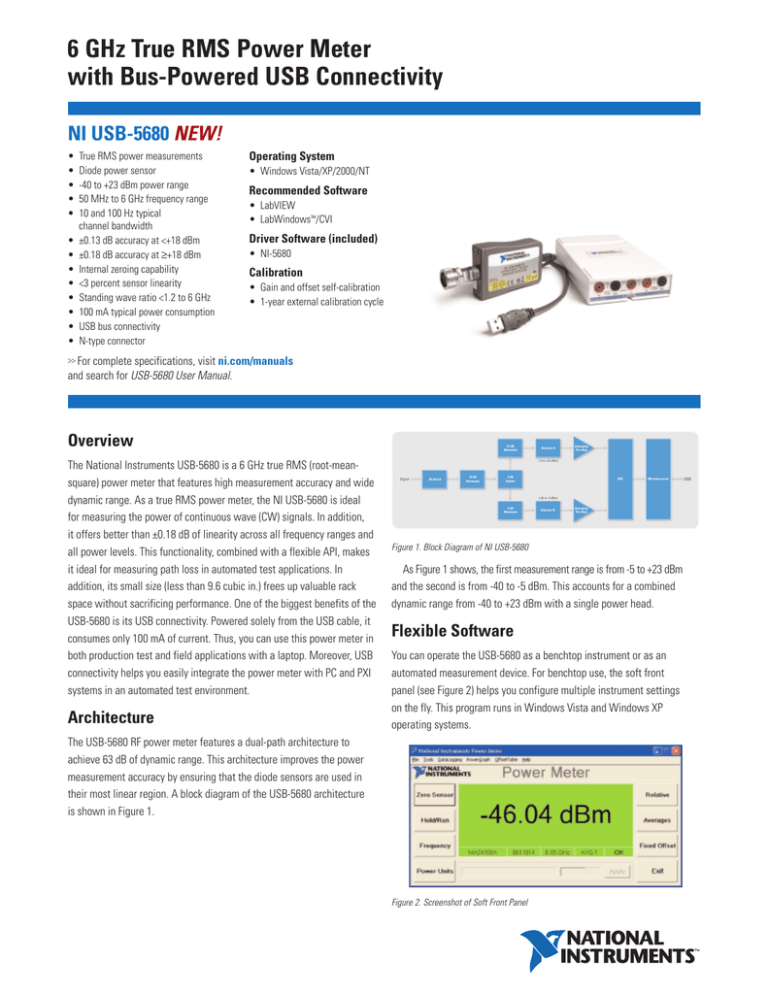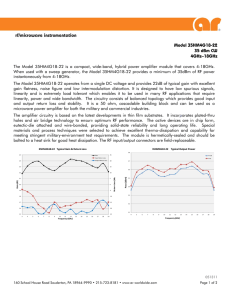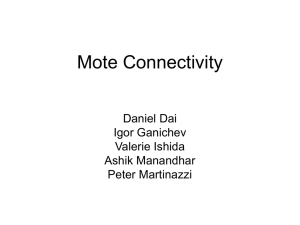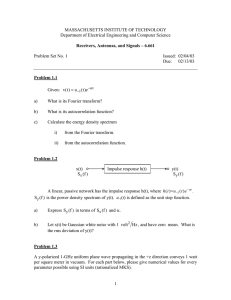
6 GHz True RMS Power Meter
with Bus-Powered USB Connectivity
NI USB-5680 NEW!
•
•
•
•
•
•
•
•
•
•
•
•
•
True RMS power measurements
Diode power sensor
-40 to +23 dBm power range
50 MHz to 6 GHz frequency range
10 and 100 Hz typical
channel bandwidth
±0.13 dB accuracy at <+18 dBm
±0.18 dB accuracy at ≥+18 dBm
Internal zeroing capability
<3 percent sensor linearity
Standing wave ratio <1.2 to 6 GHz
100 mA typical power consumption
USB bus connectivity
N-type connector
Operating System
• Windows Vista/XP/2000/NT
Recommended Software
• LabVIEW
• LabWindows™/CVI
Driver Software (included)
• NI-5680
Calibration
• Gain and offset self-calibration
• 1-year external calibration cycle
>> For complete specifications, visit ni.com/manuals
and search for USB-5680 User Manual.
Overview
The National Instruments USB-5680 is a 6 GHz true RMS (root-meansquare) power meter that features high measurement accuracy and wide
dynamic range. As a true RMS power meter, the NI USB-5680 is ideal
for measuring the power of continuous wave (CW) signals. In addition,
it offers better than ±0.18 dB of linearity across all frequency ranges and
all power levels. This functionality, combined with a flexible API, makes
it ideal for measuring path loss in automated test applications. In
addition, its small size (less than 9.6 cubic in.) frees up valuable rack
space without sacrificing performance. One of the biggest benefits of the
USB-5680 is its USB connectivity. Powered solely from the USB cable, it
consumes only 100 mA of current. Thus, you can use this power meter in
both production test and field applications with a laptop. Moreover, USB
connectivity helps you easily integrate the power meter with PC and PXI
systems in an automated test environment.
Architecture
27 dB
Attenuator
Detector A
Averaging
Pre-Amp
(-5 to +23 dBm)
Input
DC Block
10 dB
Attenuator
6 dB
Splitter
ADC
Microprocessor
(-40 to -5 dBm)
6 dB
Attenuator
Detector B
Averaging
Pre-Amp
Figure 1. Block Diagram of NI USB-5680
As Figure 1 shows, the first measurement range is from -5 to +23 dBm
and the second is from -40 to -5 dBm. This accounts for a combined
dynamic range from -40 to +23 dBm with a single power head.
Flexible Software
You can operate the USB-5680 as a benchtop instrument or as an
automated measurement device. For benchtop use, the soft front
panel (see Figure 2) helps you configure multiple instrument settings
on the fly. This program runs in Windows Vista and Windows XP
operating systems.
The USB-5680 RF power meter features a dual-path architecture to
achieve 63 dB of dynamic range. This architecture improves the power
measurement accuracy by ensuring that the diode sensors are used in
their most linear region. A block diagram of the USB-5680 architecture
is shown in Figure 1.
Figure 2. Screenshot of Soft Front Panel
USB
6 GHz True RMS Power Meter with Bus-Powered USB Connectivity
As Figure 2 illustrates, the soft front panel not only returns power
measurements but also enables the configuration of settings such as
auto-zero, number of averages, and predetermined power offsets.
In addition, you can fully program the USB-5680 with the NI-5680
driver in languages such as C, LabWindows/CVI, C++, LabVIEW, and
.NET. Using the NI-5680 driver, you can fully control the instrument and
integrate it into existing automated test applications. A screenshot of
the API is shown in Figure 3.
With the uncertainty calculator, you can enter signal characteristics
such as power, frequency, and signal type. You also can enter
measurement characteristics such as number of averages and aperture
mode. In addition to providing the absolute accuracy, the uncertainty
calculator highlights individual sources of error. As Figure 5 shows,
you can attribute an absolute accuracy of 4.45 percent to a wide range of
factors, the most significant of which include sensor nonlinearity and
mismatch uncertainty.
Figure 4. Screenshot of USB-5680 Uncertainty Calculator
Figure 3. Screenshot of the NI-5680 Driver API
Absolute Accuracy
Power sensor linearity is one of the most important characteristics of a
power meter since it greatly influences absolute accuracy. In addition,
linearity is dependent on the power level of the signal you are
measuring. As Table 1 illustrates, you can use the power sensor in its
most linear region when power levels are less than 18 dBm. Thus, the
sensor is able to provide more accurate measurements at this power
level. Linearity across all power levels is illustrated in Table 1.
Power level <18 dBm
Power level ≥18 dBm
±0.13 dB
±0.18 dB
Note that the USB-5680 uses an internal auto-zero calibration routine
to reduce errors associated with zero offsets. To do this, an internal
source is used to calibrate the power sensor, and external connectivity
is not required.
Figure 5. Expanded Sources of Error from USB-5680 Uncertainty Calculator
Table 1. Sensor Linearity According to Power Level
Note that sensor linearity is only one of many factors that
contribute to the absolute accuracy of an RF power measurement.
Because impedance mismatch (standing wave ratio, or SWR) and
noise can also add uncertainty, it is important to consider all of these
characteristics when determining overall measurement uncertainty.
National Instruments recommends downloading the Power Uncertainty
Calculator on the USB-5680 product page at ni.com to determine your
absolute measurement accuracy.
BUY ONLINE at ni.com or CALL 800 813 3693 (U.S.)
2
6 GHz True RMS Power Meter with Bus-Powered USB Connectivity
Averaging and Noise Level
Because noise can have a significant effect on the accuracy of RMS
power measurements, settings such as aperture time and averaging are
often employed to mitigate the effects of noise on measurement accuracy.
To improve flexibility, the USB-5680 features two aperture time
settings to offer both high-speed and high-accuracy options. In
“Low Aperture” mode, the power meter features a 700 ms settling time
and in “High Aperture” mode, the USB-5680 features a 70 ms settling
time. With these two options, you can choose the aperture mode and
number of averages to obtain the desired noise level of measurement.
Table 2 shows the number of averages required in both aperture modes
to achieve less than ±0.10 and ±0.01 dB noise levels.
Low-Aperature Mode
Input Power
(dBm)
>10
5
0
–5
–10
–15
–20
–25
–30
–35
–40
Input Power
(mW)
>10.0
3.2
1.0
0.32
0.10
0.032
0.010
0.0032
0.0010
0.00032
0.000100
Number of
Number of
Averages Needed
Averages Needed
For <±0.10 dB Noise For <±0.10 dB Noise
1
1
1
2
1
19
1
78
1
1
1
1
1
7
4
61
7
—
62
—
—
—
Table 3. Number of Averages, Low-Aperture Time Mode
High-Aperature Mode
Input Power
(dBm)
>0
–5
–10
–15
–20
–25
–30
–35
–40
Input Power
(mW)
1.00
0.316
0.100
0.0316
0.0100
0.00316
0.00100
0.000316
0.000100
Number of
Number of
Averages Needed
Averages Needed
For <±0.10 dB Noise For <±0.10 dB Noise
1
1
1
5
1
1
1
1
1
1
1
4
1
38
4
—
39
—
Table 2. Number of Averages, High-Aperture Time Mode
Ordering Information
NI USB-5680 ..........................................................................780167-01
Includes NI-5180 driver featuring soft front panel and API for LabVIEW, LabWindows/CVI,
C, C++ and .NET.
BUY NOW!
For complete product specifications, pricing, and accessory
information, call 800 813 3693 (U.S.) or go to ni.com/rf.
BUY ONLINE at ni.com or CALL 800 813 3693 (U.S.)
3
NI Services and Support
NI has the services and support to meet
your needs around the globe and through
the application life cycle – from planning
and development through deployment
and ongoing maintenance. We offer
services and service levels to meet
customer requirements in research,
design, validation, and manufacturing.
Visit ni.com/services.
Training and Certification
NI training is the fastest, most certain route to productivity with our
products. NI training can shorten your learning curve, save development
time, and reduce maintenance costs over the application life cycle. We
schedule instructor-led courses in cities worldwide, or we can hold a
course at your facility. We also offer a professional certification program
that identifies individuals who have high levels of skill and knowledge on
using NI products. Visit ni.com/training.
Professional Services
Our NI Professional Services team is composed of NI applications
and systems engineers and a worldwide National Instruments Alliance
Partner program of more than 600 independent consultants and
integrators. Services range
from start-up assistance to
turnkey system integration.
Visit ni.com/alliance.
OEM Support
We offer design-in consulting and product integration assistance if you
want to use our products for OEM applications. For information about
special pricing and services for OEM customers, visit ni.com/oem.
ni.com • 800 813 3693
National Instruments • info@ni.com
Local Sales and Technical Support
In offices worldwide, our staff is local to the country, giving you access
to engineers who speak your language. NI delivers industry-leading
technical support through online knowledge bases, our applications
engineers, and access to 14,000 measurement and automation
professionals within NI Developer Exchange forums. Find immediate
answers to your questions at ni.com/support.
We also offer service programs that provide automatic upgrades to
your application development environment and higher levels of technical
support. Visit ni.com/ssp.
Hardware Services
NI Factory Installation Services
NI Factory Installation Services (FIS) is the fastest and easiest way to
use your PXI or PXI/SCXI combination systems right out of the box.
Trained NI technicians install the software and hardware and configure
the system to your specifications. NI extends the standard warranty by
one year on hardware components (controllers, chassis, modules)
purchased with FIS. To use FIS, simply configure your system online
with ni.com/pxiadvisor.
Calibration Services
NI recognizes the need to maintain properly calibrated devices for
high-accuracy measurements. We provide manual calibration
procedures, services to recalibrate your products, and automated
calibration software specifically designed for use by metrology
laboratories. Visit ni.com/calibration.
Repair and Extended Warranty
NI provides complete repair services for our products. Express repair
and advance replacement services are also available. We offer
extended warranties to help you meet project life-cycle requirements.
Visit ni.com/services.
*351547A-01*
351547A-01
2007-9276-101-D
©2008 National Instruments Corporation. All rights reserved. CVI, LabVIEW, National Instruments, National Instruments Alliance Partner, NI, ni.com, and SCXI are trademarks of
National Instruments. The mark LabWindows is used under a license from Microsoft Corporation. Other product and company names listed are trademarks or trade names of their
respective companies. A National Instruments Alliance Partner is a business entity independent from NI and has no agency, partnership, or joint-venture relationship with NI.

![dB = 10 log10 (P2/P1) dB = 20 log10 (V2/V1). dBm = 10 log (P [mW])](http://s2.studylib.net/store/data/018029789_1-223540e33bb385779125528ba7e80596-300x300.png)





